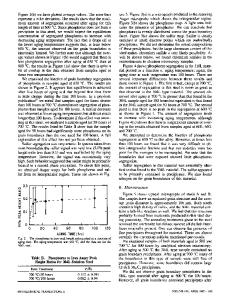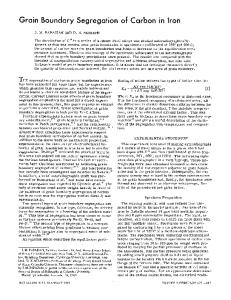On the chemistry of grain boundary segregation and grain boundary fracture
- PDF / 1,618,008 Bytes
- 16 Pages / 594 x 774 pts Page_size
- 104 Downloads / 430 Views
or
INTRODUCTION
(Mxl)gb ~ (Myl)fs + (Mx_y)fs
IT is well recognized that many impurity atoms, such as phosphorus, tin, sulfur, and antimony, segregate to the grain boundaries of many transition metals and their alloys. It is also known that the presence of these elements often lowers the cohesion of grain boundaries. Various models have been offered to explain these processes, many of which will be discussed in this paper. Yet, with the exceptions of the structural modeling of Ashby et al. tl] and the electronic modeling of various researchers, t2-8] it has not been recognized that both segregation and fracture are basically chemical processes; that is, segregation involves an alteration of chemical bonds at the grain boundaries. If this alteration creates a new set of bonds that is weaker than those that were originally present, the application of a sufficient stimulus, namely, a mechanical stress, will cause the bonds to break. One can then describe the overall process of segregation and fracture with the following set of chemical reactions:
t0 m I,.
[11
Igb + (M~)gb ~ (M~l)gb
[2]
C.L. BRIANT, Staff Scientist, is with the Research and Development Center, General Electric Company, Schenectady, NY 12301. This paper is based on a presentation made in the symposium "Interface Science and Engineering" presented during the 1988 World Materials Congress and the TMS Fall Meeting, Chicago, IL, September 26-29, 1988, under the auspices of the ASM-MSD Surfaces and Interfaces Committee and the TMS Electronic Device Materials Committee. METALLURGICAL TRANSACTIONS A
[3]
The first reaction simply describes the segregation of an impurity element, I, from the bulk, b, to the grain boundary, gb. The second reaction describes the fact that once in the boundary, the impurity will enter a structural unit of the host metal atoms, designated (M~)gb, form chemical bonds within this unit, and thus establish a new molecular unit in the grain boundary, (Mxl)g b. The third reaction describes the rupturing of this molecular unit upon the application of a stress, o', into two new units which are now located on a fracture surface, fs. The purpose of this paper is to examine these chemical reactions. Our goal is not to develop models for these processes that can be described analytically by mathematics. Rather, by using analogues from various simple chemical processes, we hope to develop clear physical pictures of segregation and fracture that will aid in thinking about them. Indeed, we would suggest that simple, intuitive models are particularly helpful for very complex problems such as these, since the more rigorous descriptions may not be available for many years to come. In the first part of this paper, we consider segregation. We suggest that segregation can be thought of as an example of heterogeneous equilibrium in which a solute is distributed between two phases. We consider various driving forces for segregation and suggest that the idea, first proposed by Hondros and Seah, [91 that the amount of grain boundary segregation is
Data Loading...











